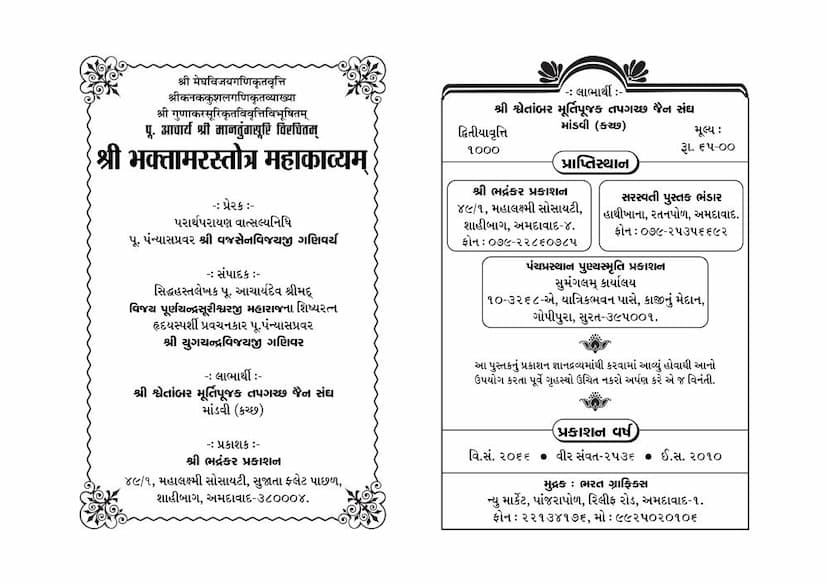Bhaktamara Sutra
Added to library: September 1, 2025

Summary
The provided text is the beginning of a Gujarati edition of the Bhaktamara Sutra, a significant Jain hymn. It includes introductory material and the first few verses with commentaries. Here's a comprehensive summary in English, based on the provided pages:
Book Title: Bhaktamara Sutra Author(s): Mantungsuri, Yugchandravijay (Editor/Compiler) Publisher: Bhadrankar Prakashan Catalog Link: https://jainqq.org/explore/009698/1
Overview:
The publication is a Gujarati rendition of the "Bhaktamara Stotra Mahakavya" (Great Epic of the Bhaktamara Hymn) composed by Acharya Manatungsuri. The edition is enriched with several commentaries:
- Shri Meghvijayganikrutvrutti: A commentary by Upadhyay Shri Meghvijayji Ganivar.
- Shri Kanakkusalgṇikṛtavākhyā: An explanation by Shri Kanakkusalgṇi.
- Shri Gunakarsurikirutvivṛttivibhūṣitam: A detailed commentary by Acharya Gunakarsuri.
The book is dedicated to the memory of various revered Jain Acharyas and is presented as a valuable resource for the Jain community, particularly for those who wish to study Jain poetry in a systematic, verse-by-verse manner. The publication aims to make the Bhaktamara Stotra, known for its spiritual power and ability to overcome obstacles, more accessible for devotional and academic study.
Key Themes and Content:
-
The Bhaktamara Stotra's Significance: The introductory sections (Editorial and Publishing Note) highlight the immense popularity and spiritual efficacy of the Bhaktamara Stotra within the Jain tradition. It is attributed to Acharya Manatungsuri, a disciple of Acharya Manadeva Suri. The fact that numerous scholars and acharyas have written commentaries on it underscores its profound influence.
-
Educational Purpose: A significant motivation behind this publication is to promote the study of Jain texts as part of the curriculum. It notes the established practice of studying Sanskrit poems like Raghuvansha and suggests that Jain poems like Bhaktamara should also be integrated. The commentary by Upadhyay Shri Meghvijayji is specifically mentioned as being suitable for Sanskrit scholars, offering a poetic approach to understanding the text.
-
Detailed Commentaries: The inclusion of multiple commentaries (Meghvijayji, Kanakkusalgṇi, and Gunakarsuri) suggests a comprehensive study of the Stotra, aiming to clarify its meaning, grammatical structure, and philosophical underpinnings. The editors express confidence that these commentaries will greatly aid in understanding the verses.
-
Structure of the Stotra (as revealed by the initial verses and commentaries):
- Verse 1-2 (Yugma): The initial verses, described as a Yugma (couplet), set the stage. The author expresses humility and acknowledges the difficulty of praising the first Jina (Tirthankara, likely Shri Rishabhanatha) who is praised by celestial beings with profound poetry. The author intends to praise the Jina after bowing respectfully to the Jina's feet.
- Dandānvaya (Syntactical Analysis): The commentary provides a detailed breakdown of the sentence structure (Dandānvaya) of the verses, clarifying the relationship between words and their grammatical roles. This indicates a rigorous, scholarly approach to the text.
- Key Concepts in the Commentary: The commentary explains the significance of bowing to the Jina's feet, describing them as radiant, illuminating, and an "alambana" (support) for beings drowning in the ocean of worldly existence (Bhava-jala). The feet are also described as the source of light that dispels the darkness of sin. The praise by celestial beings (Suranātha) is highlighted, noting their intellectual prowess derived from the knowledge of all scriptures.
-
Author's Humility and Motivation: The author (Acharya Manatungsuri) expresses humility, admitting his own limited intellect ("tannudhiya," "alpashrutam") but driven by devotion to praise the Jina. He uses metaphors to illustrate his point: a child trying to grasp the moon's reflection in water, or a deer confronting a lion for its young, highlighting the power of devotion over personal capacity.
-
Grammatical and Lexical Analysis: The commentaries delve into Sanskrit grammar (e.g., Samasa - compound words, Kṛt, Taddhita and Pratyaya suffixes, Avyaya usage) and etymology, referencing texts like Haima Kosa and various sutras to explain the precise meaning and nuances of the words.
-
Invocations and Blessings: The publication includes auspicious invocations ("Shri Rishabhanathaya Namah," "Shri Manadevasurigurubhyo Namah") and concluding blessings, reflecting the spiritual context of the text.
In essence, this publication is a scholarly and devotional edition of the Bhaktamara Stotra, aiming to provide a deep and accessible understanding of this powerful Jain hymn through multiple authoritative commentaries.